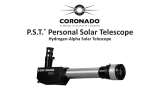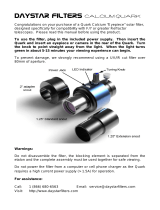Lunt Solarsystems LS100THa/B1800 H-alpha solar telescope Owner's manual
- Category
- Telescopes
- Type
- Owner's manual
This manual is also suitable for

1
Manual
LS100TH
α
-Telescope
Congratulations and thank you on your purchase of a Lunt Solar Systems solar telescope! The Lunt Solar
Systems are a new generation of solar viewing instruments utilizing the most current technologies to provide the
highest quality contrast and resolution in their class.
Warning
There are inherent dangers when looking at the Sun thru any instrument. Lunt Solar Systems has taken your
safety very seriously in the design of our systems. With safety being the highest priority we ask that you read
and understand the operation of your telescope or filter system prior to use. Never attempt to disassemble the
system. Do not use your system if it is in someway compromised due to mishandling or damage. Please contact
our customer service with any questions or concerns regarding the safe use of your instrument.
Never look at the Sun with your naked eye or with a telescope that is not specifically designed to do so.
Permanent and irreversible eye damage may result!
Never leave the solar telescope unsupervised while pointed at the Sun. People who are not familiar with
the correct operating procedures of the system may inadvertently replace the diagonal or remove the
filter itself not being aware of the integrated safety features of each.
The Lunt Solar filter/telescopes are not interchangeable with competitor products.
Handling
A Lunt Solar Systems solar telescope houses many optical elements that are all pre-aligned and fixed at the
factory. There are no user serviceable parts inside the scope. The telescope should never be taken apart. This
will not only void your warranty leading to costly repairs, it can only serve to further damage the instrument and
compromise its safety.
Most Lunt Solar Systems filters and telescopes house a delicate optical element referred to as an Etalon. These
Etalons are suspended in the system housing in an effort to both protect it and isolate it from outside influences,
which could de-tune the Etalon filter. Extensive research has been done to assure the best performance of what
is essentially the "heart" of the system while protecting it from the day-to-day bumps, jarring, and vibrations of
normal use.
However, the instrument should never be subjected to shock due to being dropped. Mishandling of the filters
system will cause the Etalon to de-contact (not covered under warranty) and will render the instrument useless
until repaired.
The instrument should be stored in its original case. As with any precision optical instrument it should be kept in
as low a humidity area as possible.
With proper handling and care the filter should last a lifetime.
Cleaning
As with most telescopes and equipment there will be a build up of dust and debris on the lens and mechanical
components after sitting out all day. For those who are familiar with cleaning telescopes we recommend you use
the same techniques. For those who are new to the care of these instruments we can offer the following
guidelines:
Blow off loose dust and dirt using a clean dry air source at low volume. Do not use shop compressed air, which
contains oil and will further contaminate the instrument. Stubborn particulates can be brushed from the surface
with a static free lens brush. Use gentle sweeping motions. Fingerprints and smudges can be removed using
lens tissue or a Kleenex type tissue product. Fold the tissue or cloth to make a "pad", apply a cleaning product to
the end of the pad dampening it evenly (do not apply solution to the lens), wipe in circular motion starting at the
center and working around the edge and off in one complete motion. Be firm, but do not rub. Blow lightly to help
remove residual solution before it "spots" the surface. Residual dust from the cloth can be blown off.
Consult your local dealer or call Lunt Solar Systems with any questions or concerns.

2
Do not use Acetone or strong degreaser type products, household cleaning agents, paper towels, tissues with
added scent or color (plain tissues only), or bleach or acidic products which will damage the anodized surfaces.
What am I looking at?
The Sun is active on a daily basis. During solar maximum the Sun will put on awe inspiring displays that include
x-class flares, prominences, surface filaments, etc…
Prominences: These look like eruptions from the disk (edge) of the Sun. Prominences can be small spiky
looking details, or large cloud like detail with fine feather like internal features. They are, in fact, ionized
hydrogen emissions being projected from the limb. Prominences are anchored to the Sun's surface in the
mesosphere, and extend outwards into the Sun's troposphere.
Filaments: These are string like features on the surface of the Sun. At high resolution they take on a 3D effect
due to the cooler aspect of the filament contrasted against the bright, hotter, Sun. They are actually prominences
being viewed against the surface.
Spicules: A spicule is a dynamic jet of about 500km diameter on the Sun. It moves upwards at about 20 km/s
from the photosphere. Father Angelo Secchi of the Vatican Observatory in Rome discovered them in 1877. The
chromosphere is entirely composed of spicules. These features can be seen as "fur" around the edge of the
disk.
Plage: This is a bright region in the chromosphere of the Sun, typically found in regions of the chromosphere
near sunspots. The plage regions map closely to the faculae in the photosphere below, but the latter have much
smaller spatial scales. Faculae have a strong influence on the solar constant, and the more readily detectable
because chromospheric plage areas traditionally are used to monitor this influence.
Solar Flares: A solar flare is a violent explosion in the Sun's atmosphere. Solar flares take place in the solar
corona and chromospheres, heating plasma to tens of millions of Kelvin and accelerating electron, protons, and
heavier ions to near the speed of light. They produce electromagnetic radiation across the electromagnetic
spectrum at all wavelengths from long-wave radio to the shortest wavelength gamma rays. Most flares occur in
active regions around sunspots, where intense magnetic fields emerge from the Sun's surface into the corona.
Flares are powered by the sudden (timescales of minutes to tens of minutes) release of magnetic energy stored
in the corona.
Chromosphere: The chromosphere is a thin layer of the Sun's atmosphere just above the photosphere, roughly
10,000 kilometers deep (approximating to, if a little less than, the diameter of the Earth). The chromosphere is
more visually transparent than the photosphere. The name comes from the fact that it has a reddish color, as the
visual spectrum of the chromosphere is dominated by the deep red H-alpha spectral line of hydrogen.
The LS100TH
α
Telescope
The LS100THa is a complete H-alpha Solar Telescope with a 102 mm aperture and 714 mm focal length. An
internal etalon with new air-pressure tuning system adjustment allows for a <0.7 Angstrom bandwidth. The
“Pressure Tuner” system adapted the Etalon to varying altitudes and atmospheric pressures for always optimal
performance. Blocking filter is alternatively the B1200, the B1800 (better for imaging), or the B3400 (only needed
for imaging with very large CCD’s). The star diagonal in which the blocking filter B1200 or B1800 is installed, is
equipped as standard for 1.25" eyepieces and with a T2 camera connection. The large B3400 is fix installed
inside the Feather-Touch focuser. Focusing is achieved with a high precision Starlight Instruments 2" Feather
Touch focuser with 10:1 reduction as standard equipment.
What is delivered with the system?
- H-alpha telescope with internal Etalon and 102mm aperture
- Blocking filter B1200, B1800 or B3400 (not included at the OTA version)
- Starlight Instruments Feather Touch focuser
- Tube ring with dovetail plate
- Sol searcher
- Transport case with die cut foam insert
- Instruction manual
What accessories are recommended?
- Eyepieces: Simple eyepieces with narrow field of view are recommended. (25mm thru 8mm)

3
Okay let's get started...
Note:
- The telescope is shipped with the dovetail and sol searcher removed for safety during shipping. We
recommend that you use an exact type knife to modify the foam insert as required after you have setup the solar
scope and you are happy with the placement of the rings and the sol searcher.
- The telescope can be transported by careful hand carrying in the case with these items attached. However, we
strongly recommend that these items be removed for transportation via commercial carrier.
- During shipping the tension screw of the feather touch focuser may become loose. Simply tighten the screw as
required or refer to the Starlight Instruments instructions that are provided.
Safety First!
- Always check any telescope before use. Do not use any telescope or filter that appears to be damaged.
Verify that all glass and filters are in place.
- The Blocking Filter diagonal or extension tube must always be used with the Lunt telescope or filter.
So you have your LS100THa setup on a tripod or mount. Let's take a look!
Place a ~25mm eyepiece in the focus end so you have the largest field of view to look at.
Pull the diagonal slide tube out about 50mm. Put the focus tube at about 50% of travel.
If you do not have a Sol Searcher you can use the shadow cast by the Sun on the front objective cell against the
clamshell. Center one on the other and you should be close. Look thru the eyepiece. Do you see a fuzzy red
ball? If not, make sure you have removed the dust cap from the front. Try to re-align the Sol Searcher and look
again. After some trial and error the Sun should appear in the eyepiece. Once the Sun is centered now is a good
time to adjust that Sol Searcher.
Focus: It is amazing how many people walk up to a solar telescope and take a quick look thru without ever
focusing. Course focus is achieved by moving the diagonal drawtube in and out. Medium focus is achieved using
the larger silver knobs on either side of the focuser assembly. Fine focus is achieved with the 10:1 reduction
(smaller gold knob). The fine focus is often too fine for visual use, but comes in very handy if you are imaging.
Focus so that the edge of the Sun is as sharp as possible.
Tuning: On the side of the scope is a large black cylinder. This cylinder is the tuning system for the H-alpha
filter. Now we will describe how to bring 656.28nm wavelength on band. The black handle of the cylinder system
has a 4 start thread attaching it to the brass cylinder body. Unscrew the black handle completely and carefully
pull the piston from the cylinder. There may be some resistance and a faint pop as the air enters the cylinder.
This is normal. This has reset the system for your altitude. Carefully re-thread the handle onto the body and
engage the threads about one turn. While looking thru the eyepiece gently turn the black handle onto the
cylinder body. There will be little resistance at first, but as the pressure in the cylinder builds the resistance will
increase slightly. As you turn the cylinder you should see features come into view thru the eyepiece. Continued
turning will result in the wavelength shifting thru 656.28nm and detail will begin to disappear. Fine-tune the
cylinder for the best performance.
A few details regarding the pressure tune system. The amount of pressure being supplied to the etalon cavity is
minimal. It is the equivalent of going from -150m below sea level to about 3,000m. Or around 0.1 Bar, there is no
risk of explosion. We are dealing with only a fraction of 1 atmosphere. When not in use we recommend that you
release the pressure by simply backing off the black handle from the cylinder body. If the system unthreads
completely, simply thread it back on 1 turn. It is not necessary to re-set the system every time it is used. Re-
setting may only be required if the system has been sitting for a long period of time.
Re-Focus: When you feel you have tuned effectively, re-focus the telescope. The finer details should come into
view. Try to relax the eye while observing and let the details come to you.
Change the eyepiece: When you have a good feel for observing at lower magnifications try to increase the
magnifications in small steps. Place an interesting artifact in the center of the field. Replace the 25mm with a 8 -
12mm eyepiece. Look thru the eyepiece and re-focus carefully. The image has dimmed slightly due to higher
magnification but the details should be easier to see. You can push the magnification as seeing conditions allow.

4
A few more definitions
Hydrogen-alpha: The wavelength of light in the spectrum that these scopes allow you to look at. Centered at
656.28nm.
Bandwidth: The width of light at a given wavelength that is allowed to pass. The LS100THa is <0.7 Angstrom.
As bandwidth is reduced more surface detail of the Sun can be resolved. This can be accomplished thru double-
stacking with an LS100FHa Filter (<0.5 Angstrom).
Angstrom: The unit of measurement for light. 1 Angstrom = 0.1nm.
Etalon: A resonating cavity produced thru the fabrication of highly precise optical surfaces.
Technical data
Aperture: 102mm
Focal Length: 714mm
Bandwidth: <0.7 Angstrom
Tuning: air-pressure tuning system “Pressure Tuner”
Weight: 5.7kg
Length: 62cm
Lunt-Solar-Systems - Exclusive European Distributor
Bresser GmbH
Gutenbergstrasse 2, D-46414 Rhede, Germany
Phone: +49 (0) 2872 – 80 740
E-Mail: [email protected]
www.bresser.de
-
 1
1
-
 2
2
-
 3
3
-
 4
4
Lunt Solarsystems LS100THa/B1800 H-alpha solar telescope Owner's manual
- Category
- Telescopes
- Type
- Owner's manual
- This manual is also suitable for
Ask a question and I''ll find the answer in the document
Finding information in a document is now easier with AI
Related papers
-
Lunt Solarsystems 0551275 Owner's manual
-
Lunt Solarsystems 0551147 Owner's manual
-
Lunt Solarsystems LS130THa/B3400 H-alpha solar telescope Owner's manual
-
Lunt Solarsystems LS80THa/B1200CPT H-alpha solar telescope Owner's manual
-
Lunt Solarsystems LS152THa/B1800 H-alpha solar telescope Owner's manual
-
Lunt Solarsystems LS60FHa/B600d2 H-alpha solar filter Owner's manual
-
Lunt Solarsystems LS60THa/B1200FTPT H-alpha solar telescope Owner's manual
-
Lunt Solarsystems LS60THaDS50/B1200C H-alpha solar telescope Owner's manual
-
Lunt Solarsystems LS100MT/B3400FT Multipurpose APO Telescope for Sun + Night-Sky Owner's manual
-
Lunt Solarsystems LS800MT/B1800C Multipurpose APO Telescope for Sun + Night-Sky User manual
Other documents
-
 Lunt Solar Systems LS80THa Quick start guide
Lunt Solar Systems LS80THa Quick start guide
-
Bresser MikrOkular Full HD eyepiece camera Owner's manual
-
United Nursery 74677 User manual
-
Meade SMIII 90mm Owner's manual
-
Kenney 80421REM Installation guide
-
Orion Safety Products 8907 Specification
-
 Coronado 0.5PST User manual
Coronado 0.5PST User manual
-
 DayStar Filters CALCIUM QUARK User manual
DayStar Filters CALCIUM QUARK User manual
-
Bresser Raptor WIFI 3D Printer Owner's manual
-
Meade SolarMax III 70mm Owner's manual






